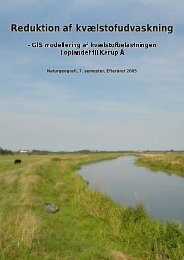Deglaciation dynamics following the Little Ice Age on Svalbard:
Deglaciation dynamics following the Little Ice Age on Svalbard:
Deglaciation dynamics following the Little Ice Age on Svalbard:
You also want an ePaper? Increase the reach of your titles
YUMPU automatically turns print PDFs into web optimized ePapers that Google loves.
Søren H. Rasmussen<br />
The fr<strong>on</strong>t moraine of Larsbreen is<br />
starting around 150 m altitude and <str<strong>on</strong>g>the</str<strong>on</strong>g><br />
clean glacier ice is reach from ca. 250 to<br />
800 m altitude, see figure 1. The outlet<br />
valley part of <str<strong>on</strong>g>the</str<strong>on</strong>g> glacier is <strong>on</strong>ly <str<strong>on</strong>g>the</str<strong>on</strong>g><br />
nor<str<strong>on</strong>g>the</str<strong>on</strong>g>rn part, from 500 m altitude and<br />
down.<br />
At <str<strong>on</strong>g>the</str<strong>on</strong>g> fr<strong>on</strong>t of Larsbreens moraine are<br />
rock-glacier, <str<strong>on</strong>g>the</str<strong>on</strong>g>se are laying largely parallel<br />
with <str<strong>on</strong>g>the</str<strong>on</strong>g> fr<strong>on</strong>tal moraine. Under <str<strong>on</strong>g>the</str<strong>on</strong>g> LIA<br />
advance Larsbreen has pushed to rockglaciers<br />
(Humlum, 2005).<br />
Platåbreen starts <strong>on</strong> <str<strong>on</strong>g>the</str<strong>on</strong>g> nor<str<strong>on</strong>g>the</str<strong>on</strong>g>rn side of<br />
mountain top Nordenskjöldfjellet (1050 m)<br />
and follow a broad flat valley down to <str<strong>on</strong>g>the</str<strong>on</strong>g><br />
plateau at Platåbjerget. The fr<strong>on</strong>t moraine<br />
is lying around 450-600 m altitude.<br />
The valley under Larsbreen is more V-<br />
<str<strong>on</strong>g>the</str<strong>on</strong>g>n U-shaped, with indicated less erosi<strong>on</strong><br />
and <str<strong>on</strong>g>the</str<strong>on</strong>g>refore a cold-based glacier (Lukas<br />
et al., 2005).<br />
Most of <str<strong>on</strong>g>the</str<strong>on</strong>g> glaciers <strong>on</strong> <strong>Svalbard</strong> have<br />
retreating since <str<strong>on</strong>g>the</str<strong>on</strong>g> LIA maximum ca.<br />
1890-1900 (Glasser and Hambrey, 2006).<br />
This is also <str<strong>on</strong>g>the</str<strong>on</strong>g> case for Lars- and Platåbreen.<br />
The two glacier is believed to be<br />
more than 100 years out of climate equilibrium,<br />
with mean <str<strong>on</strong>g>the</str<strong>on</strong>g>y still resp<strong>on</strong>ds <strong>on</strong><br />
<str<strong>on</strong>g>the</str<strong>on</strong>g> climate that was around 100 years ago<br />
(Lukas et al., 2005).<br />
There is no observati<strong>on</strong> of surging of<br />
<str<strong>on</strong>g>the</str<strong>on</strong>g>se glaciers (Lukas et al., 2005).<br />
Methods<br />
Mapping of Larsbreen and Platåbreen<br />
was carried out in <str<strong>on</strong>g>the</str<strong>on</strong>g> last half of<br />
September 2006. The basic map was a<br />
digital redrawing of <str<strong>on</strong>g>the</str<strong>on</strong>g> topographic map<br />
in 1:100,000 from Norwegian Polar<br />
Institute (2000). On <str<strong>on</strong>g>the</str<strong>on</strong>g> basic map, in <str<strong>on</strong>g>the</str<strong>on</strong>g><br />
scale 1:5000, observati<strong>on</strong>s were drawn in<br />
<str<strong>on</strong>g>the</str<strong>on</strong>g> field and later digitalised. In <str<strong>on</strong>g>the</str<strong>on</strong>g> field a<br />
compass was used for orientati<strong>on</strong> and<br />
measurements.<br />
Figure 3 and 5 are showing <str<strong>on</strong>g>the</str<strong>on</strong>g> result of<br />
<str<strong>on</strong>g>the</str<strong>on</strong>g> mapping. There are two sets of c<strong>on</strong>tour<br />
lines some from Norwegian Polar Institute<br />
(2000) (solid lines) and approximated<br />
<str<strong>on</strong>g>Deglaciati<strong>on</strong></str<strong>on</strong>g> <str<strong>on</strong>g>dynamics</str<strong>on</strong>g> <str<strong>on</strong>g>following</str<strong>on</strong>g> <str<strong>on</strong>g>the</str<strong>on</strong>g> <str<strong>on</strong>g>Little</str<strong>on</strong>g> <str<strong>on</strong>g>Ice</str<strong>on</strong>g> <str<strong>on</strong>g>Age</str<strong>on</strong>g> <strong>on</strong> <strong>Svalbard</strong>:<br />
Implicati<strong>on</strong> of debris-covered glaciers dynamic and morphological setting<br />
Page 5 of 15<br />
c<strong>on</strong>tour lines (dash lines) from field<br />
investigati<strong>on</strong>s. The c<strong>on</strong>tour lines from<br />
Norwegian Polar Institute (2000) are<br />
assumed to be right, even though <str<strong>on</strong>g>the</str<strong>on</strong>g> scale<br />
is bigger. This means <str<strong>on</strong>g>the</str<strong>on</strong>g>re could be some<br />
inaccuracy. The c<strong>on</strong>tour lines are for<br />
giving <str<strong>on</strong>g>the</str<strong>on</strong>g> reader a principle picture of <str<strong>on</strong>g>the</str<strong>on</strong>g><br />
morphology and <str<strong>on</strong>g>the</str<strong>on</strong>g>refore <str<strong>on</strong>g>the</str<strong>on</strong>g> inaccuracy is<br />
not c<strong>on</strong>sidering as a problem.<br />
The field data have been compared with<br />
aerial photos from Norwegian Polar<br />
Institute (1990) and <str<strong>on</strong>g>the</str<strong>on</strong>g> Geomorphological<br />
and Quaternary Geological map of Adventdalen<br />
from Tolgensbakk et al. (2000).<br />
Observati<strong>on</strong>s<br />
Platåbreen<br />
The moraines of Platåbreen is mainly a<br />
symmetric c<strong>on</strong>cave form, apart from a<br />
t<strong>on</strong>gue reaching down towards Tverrdalen,<br />
see figure 1 and 3. There is a medial<br />
moraine c<strong>on</strong>sisting of three groups, with a<br />
form like drops. The lateral moraines is<br />
around 100 m, <str<strong>on</strong>g>the</str<strong>on</strong>g> fr<strong>on</strong>tal moraine is ca.<br />
500 m wide, <str<strong>on</strong>g>the</str<strong>on</strong>g> distance from <str<strong>on</strong>g>the</str<strong>on</strong>g> clean<br />
glacier ice to <str<strong>on</strong>g>the</str<strong>on</strong>g> end of <str<strong>on</strong>g>the</str<strong>on</strong>g> moraine<br />
reaching down to Tverrdalen is 800 m. The<br />
medial moraine is 500 m l<strong>on</strong>g. On <str<strong>on</strong>g>the</str<strong>on</strong>g> top<br />
of <str<strong>on</strong>g>the</str<strong>on</strong>g> fr<strong>on</strong>tal moraine are some l<strong>on</strong>g small<br />
hills largely <str<strong>on</strong>g>following</str<strong>on</strong>g> <str<strong>on</strong>g>the</str<strong>on</strong>g> c<strong>on</strong>cave shape<br />
of <str<strong>on</strong>g>the</str<strong>on</strong>g> moraine, see figure 4.<br />
The western lateral moraine is mainly<br />
<strong>on</strong>e l<strong>on</strong>g hill, when it reach <str<strong>on</strong>g>the</str<strong>on</strong>g> fr<strong>on</strong>tal<br />
moraine it splits op in <str<strong>on</strong>g>the</str<strong>on</strong>g> previous<br />
menti<strong>on</strong>ed small hills. Outside <str<strong>on</strong>g>the</str<strong>on</strong>g> lateral<br />
moraine is <str<strong>on</strong>g>the</str<strong>on</strong>g> wea<str<strong>on</strong>g>the</str<strong>on</strong>g>ring bedrock of black<br />
shale and water has cut channels into it.<br />
These channels are merging with channels<br />
running <strong>on</strong> <str<strong>on</strong>g>the</str<strong>on</strong>g> lateral moraine. On <str<strong>on</strong>g>the</str<strong>on</strong>g><br />
glacier-side of <str<strong>on</strong>g>the</str<strong>on</strong>g> western lateral moraine<br />
melt-water channels from <str<strong>on</strong>g>the</str<strong>on</strong>g> glacier is<br />
running. These meltwater channels are<br />
meting in <strong>on</strong>e channel before its run over<br />
<str<strong>on</strong>g>the</str<strong>on</strong>g> fr<strong>on</strong>tal moraine. It is <strong>on</strong>e of <str<strong>on</strong>g>the</str<strong>on</strong>g> two<br />
large meltwater channels <str<strong>on</strong>g>the</str<strong>on</strong>g>re are parsing<br />
through <str<strong>on</strong>g>the</str<strong>on</strong>g> fr<strong>on</strong>tal moraine. The channel is<br />
eroded down into <str<strong>on</strong>g>the</str<strong>on</strong>g> fr<strong>on</strong>tal moraine and<br />
making steep channel sides. Outside of <str<strong>on</strong>g>the</str<strong>on</strong>g>







